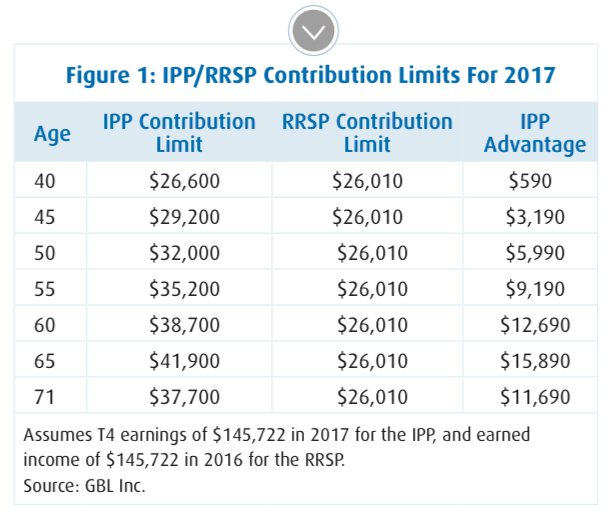Individual Pension Plans: A Retirement Solution for Business Owners
Scot McLeod - Mar 27, 2018
The federal government recently introduced tax proposals designed to offset certain tax planning strategies within private corporations. In light of the proposals, many business owners and incorporated professionals are re-visiting the viability of investing passively through their corporation and may be considering alternative tax planning strategies, such as Individual Pension Plans (“IPPs”) to help them save for retirement.
Who Can Benefit from an IPP?
-
Business owners or incorporated professional (e.g. doctor, dentist, lawyer, etc.)
-
Between ages of 40 and 71
-
Receiving T4 income over $145,722 per year from the sponsoring company (you must be an employee of your corporation)
-
Looking for additional retirement income beyond what can be provided for within RRSP limits
Key Benefits of an IPP over RRSP
-
Increases your retirement assets and allows your company to make large tax-deductible contributions
-
Allows for signficant additional lump-sum contributions at inception and at retirement
-
Allows for top-up contributions if the rate of return on plan assets is less than 7.5% per year
-
Safer investment rules and limitations compared to RRSP
-
Any pension plan surpluses belong to you (the plan member) and can be held in the plan for the benefit of other members or paid to the estate
-
Defined benefit plan makes your retirement income consistent and predictable
-
100% creditor proof
-
No deemed disposition of plan assets upon death in certain situations - plan assets remain in the plan to provide benefits to surviving members
-
All costs and fees associated with the pension plan are tax deductible to the company
How an IPP works
An IPP is a registered pension plan established for a single plan member, and provides an effective way for your business to fund your retirement pension while reducing corporate income taxes. A business can deduct the cost of the initial lump-sum contribution for past service when the IPP is established, as well as ongoing eligible IPP contributions. In addition, all costs and reasonable expenses related to the maintenance of the IPP (such as investment fees) are tax deductible to the company.
IPPs are ideally suited for business owners between the ages of 40 and 71 who earn (T4) income over $145,722 per year; providing several advantages over using a Registered Retirement Savings Plan (“RRSP”) for retirement savings.
Greater certainty of retirement benefits
As a defined benefit pension plan, the IPP must fund a guaranteed retirement benefit based on the plan member’s T4 employment earnings and is determined by an actuarial formula. The annual IPP contribution is equal to the cost of funding the pension benefit (as calculated by an actuary). Depending on your situation, annual IPP contribution limits can be significantly higher than RRSP contribution limits, and increase with age. At around age 40, the annual IPP contribution limit equals that of RRSPs, and continues to increase in subsequent years.
Because IPPs are intended to provide a predictable retirement income stream for the planholder, employer contributions can be topped up when investment returns are less than 7.5%. An actuarial valuation must be performed every three-years, and any funding shortfall may require further contributions which can be made over a five-year period. However, if a funding surplus is generated, the employer may need to take a “contribution holiday.”
Figure 1 compares the 2017 IPP and RRSP contribution limits for an individual earning $145,722. While the RRSP contribution limit remains static regardless of the contributor’s age, IPP contribution limits vary depending on the age of the IPP plan member. Note that the IPP contribution limit is significantly higher than the RRSP limit.

Retirement income payments
Once a business owner is ready to retire, which can be as early as age 50, IPP assets can be used to pay a guaranteed retirement benefit amount, or transferred to a locked-in retirement plan to provide future pension benefits. IPP payments are considered taxable income in the year they are received by the plan member.
Eligible investments
Generally, investments eligible for an RRSP are also acceptable for IPPs. However, there is a 10% investment concentration limit on any one security, in order to ensure broad diversification of the plan assets. Related party investments (i.e., shares of a plan member’s company) cannot be held within the IPP. In addition, assets within an IPP are protected from creditors.
A retirement savings option worth exploring
IPPs provide generous contribution limits, creditor protection, a guaranteed income at retirement, and the ability for your company to make tax deductible contributions to the plan on your behalf. These benefits make IPPs an attractive option to consider versus saving for retirement using an RRSP.
Click here to download the article
Talk to a Professional
To determine whether an Individual Pension Plan is appropriate for your retirement needs or to request a personalized quote, contact the McLeod Wealth Management group directly for a complimentary consultation.
Call (780) 945-5227
or